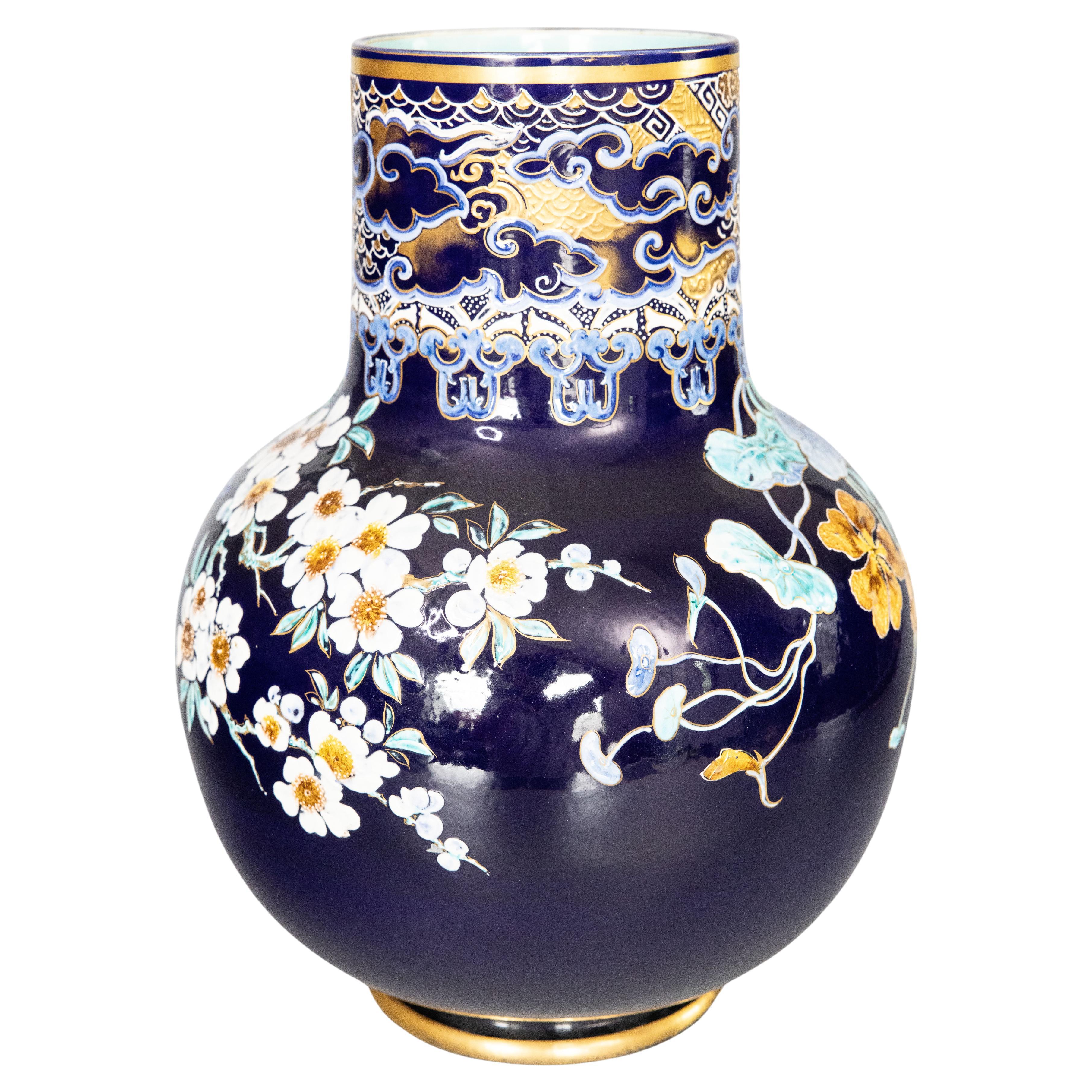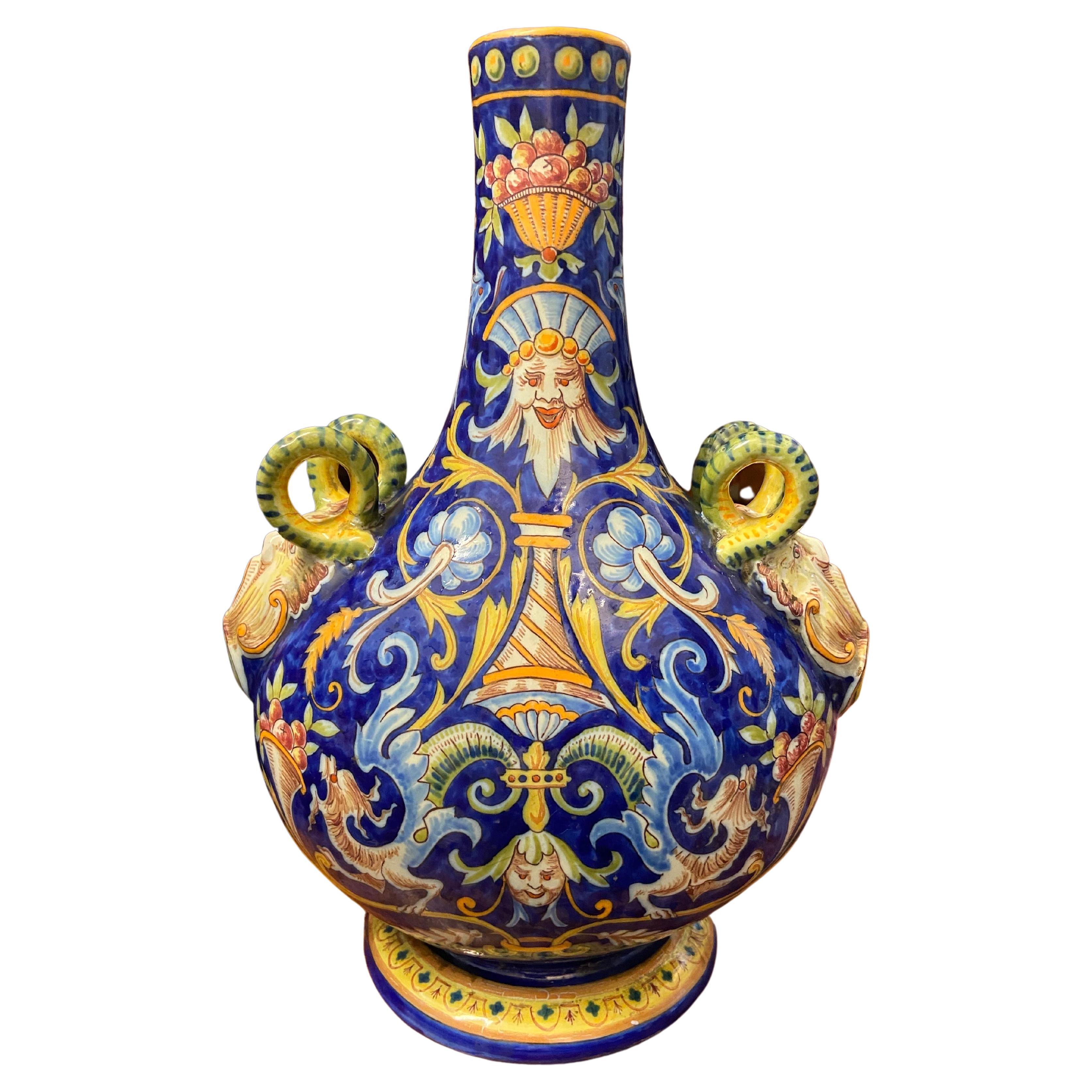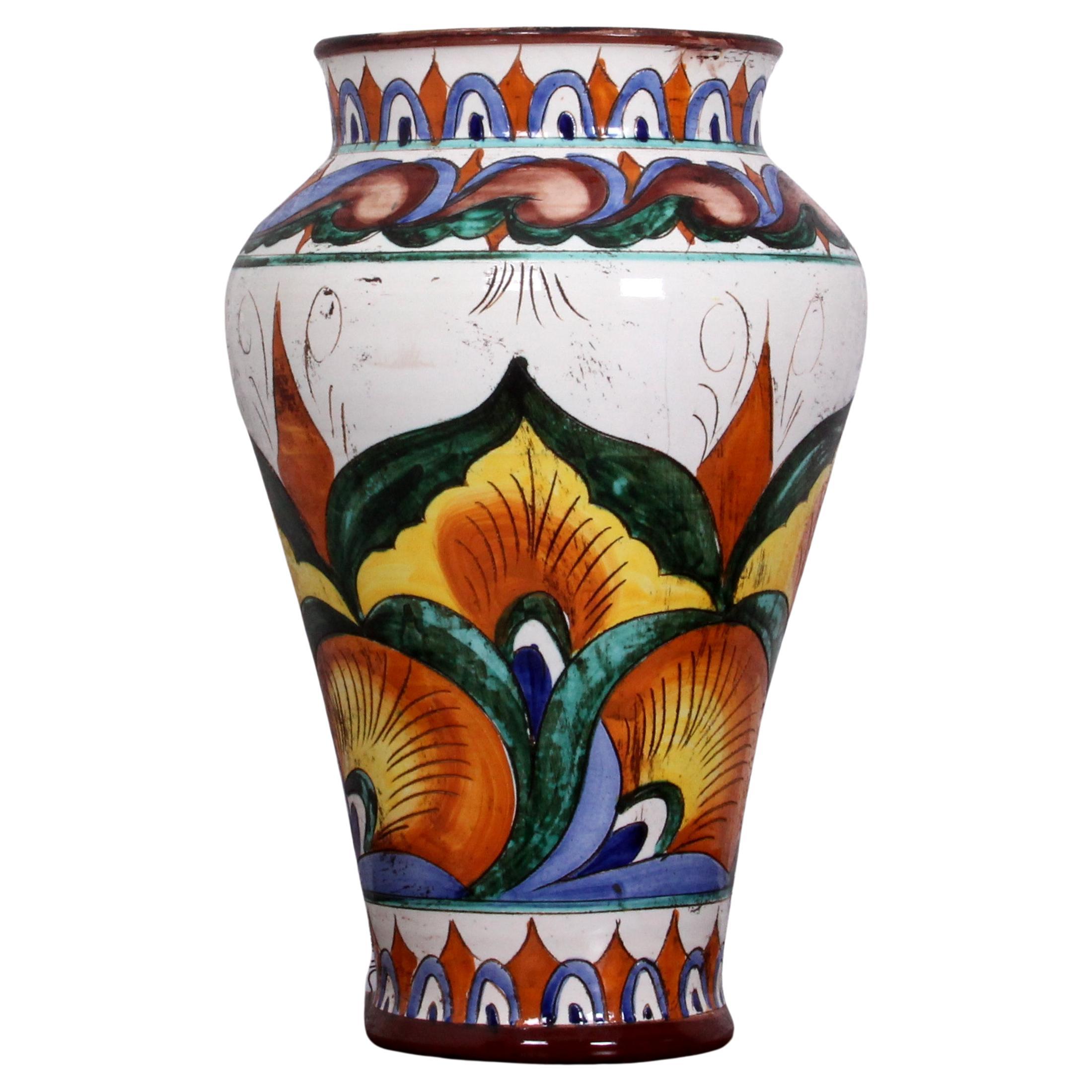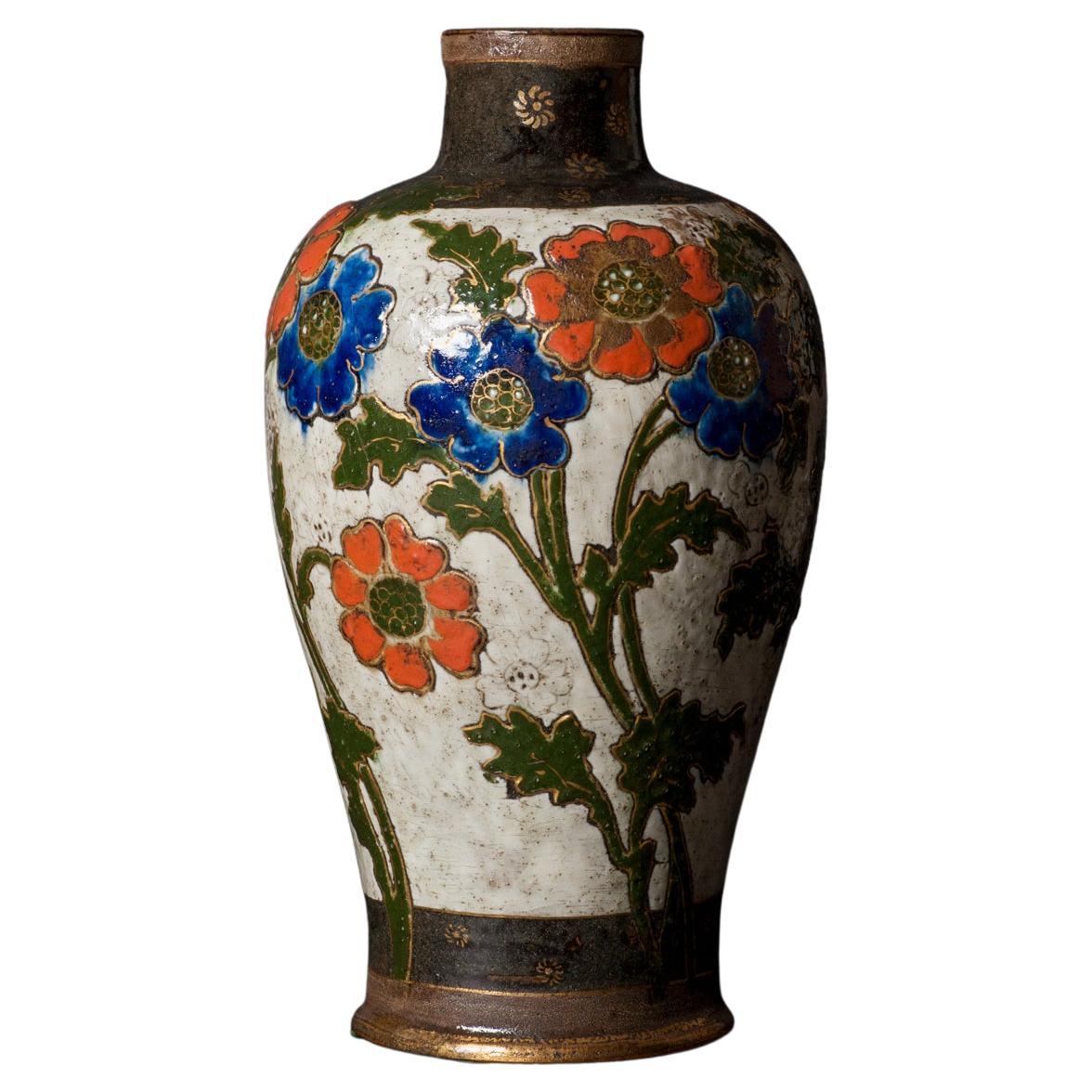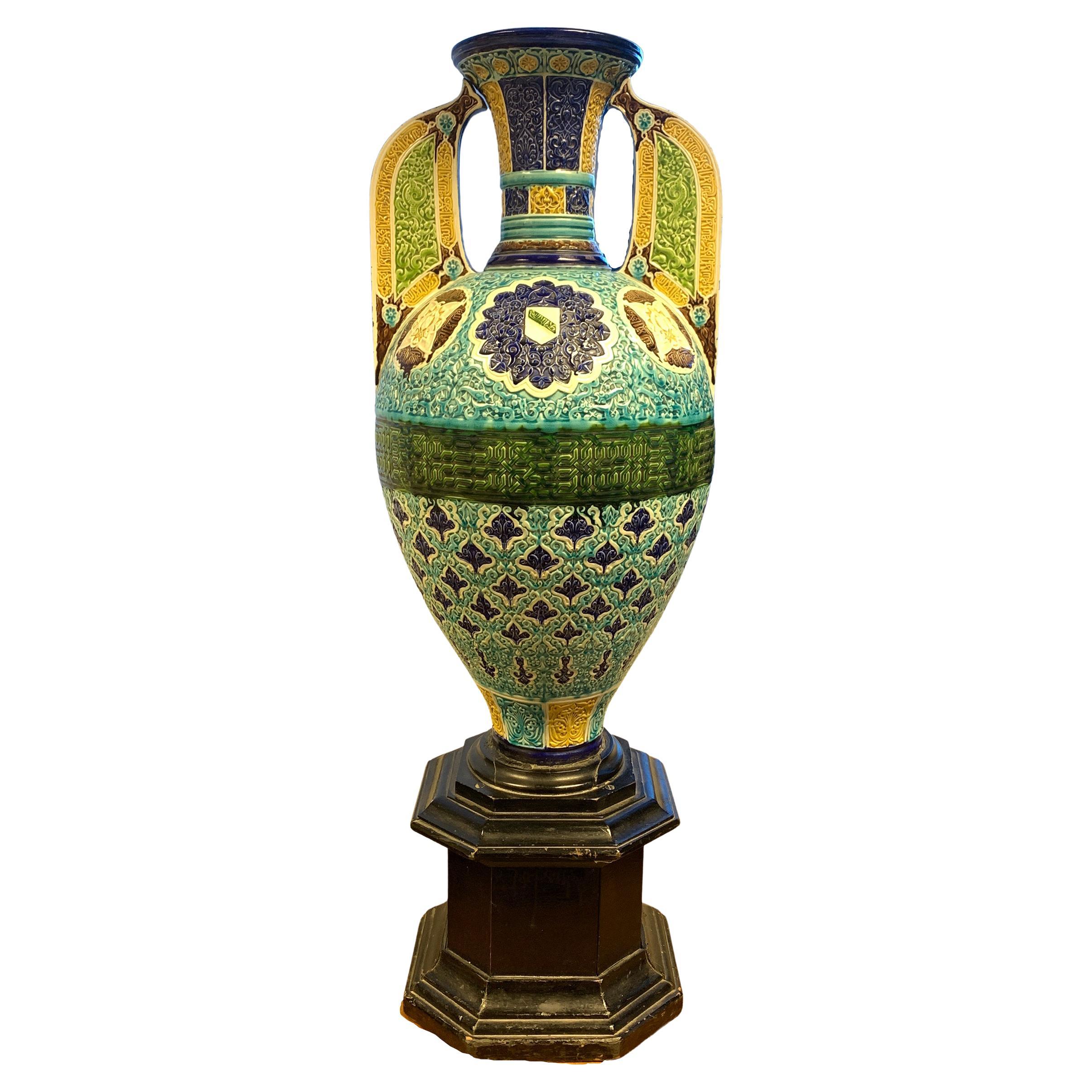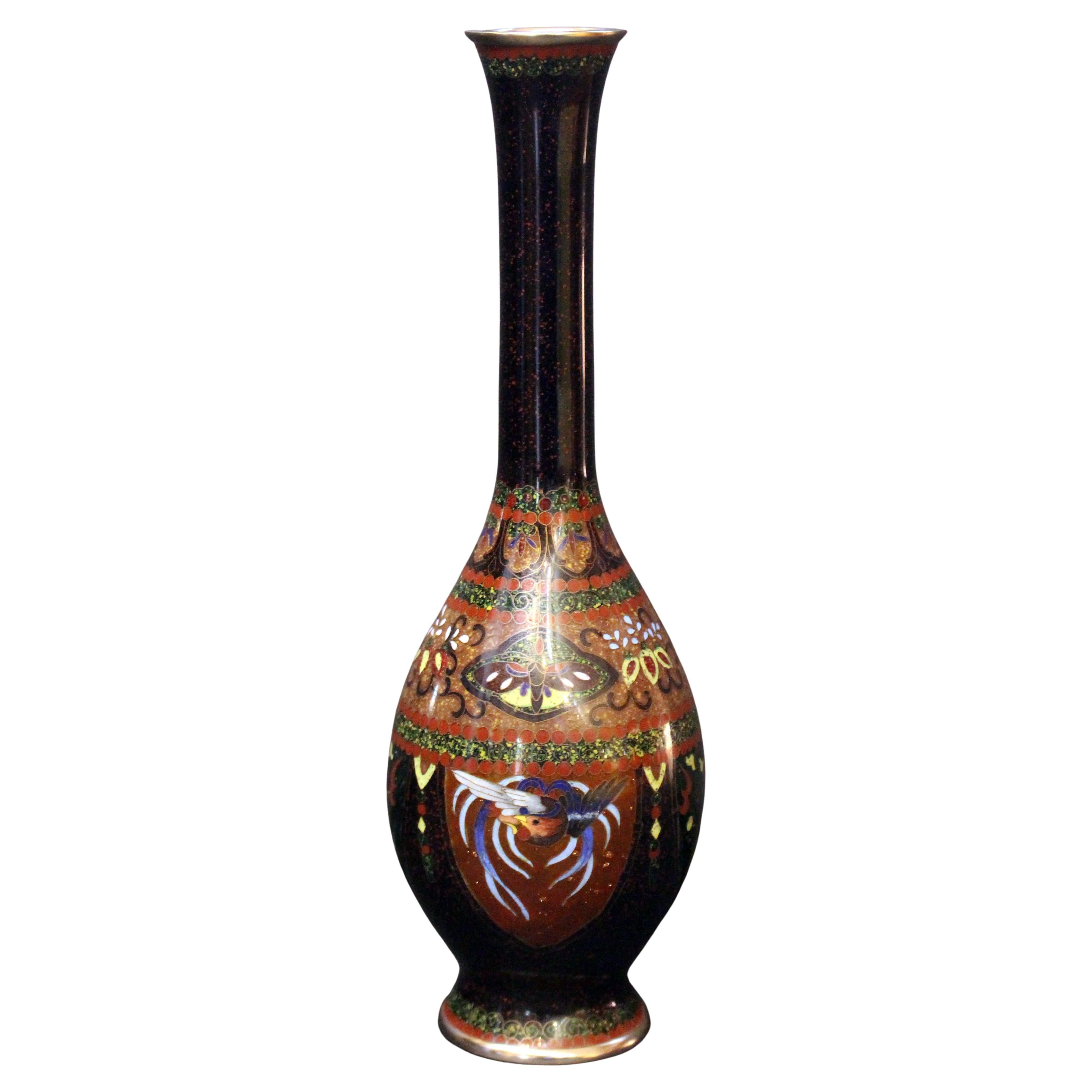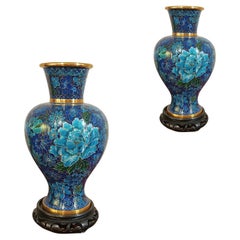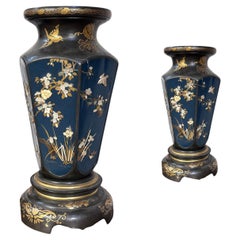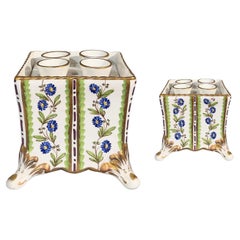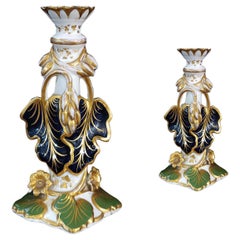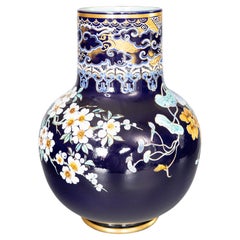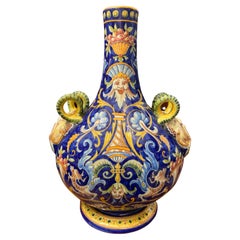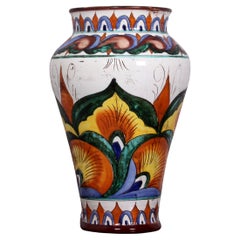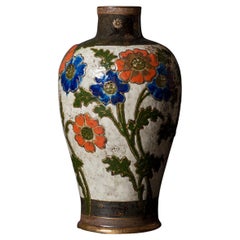Items Similar to 19th Century Liberty Gibus & Redon Polychrome Vase
Want more images or videos?
Request additional images or videos from the seller
1 of 8
19th Century Liberty Gibus & Redon Polychrome Vase
$1,004.55
£746.77
€840
CA$1,401.32
A$1,520.12
CHF 799.36
MX$18,496.79
NOK 9,993.34
SEK 9,424.94
DKK 6,397.11
About the Item
Characteristic four-handled polychrome majolica vase born from the artistic collaboration of Gibus and M. Redon. The object represents a fusion of Neo-Renaissance and Art Nouveau features. Mark bearing the monogram of the artistic collaboration under the base.
Measurements: HxL 27 x 15 cm
- Creator:Pierre-Justin Gibus (Artist)
- Dimensions:Height: 10.63 in (27 cm)Diameter: 5.91 in (15 cm)
- Style:Art Nouveau (In the Style Of)
- Materials and Techniques:
- Place of Origin:
- Period:
- Date of Manufacture:1870
- Condition:We remind you that the authorization of the Fine Arts is required for the export.
- Seller Location:Firenze, IT
- Reference Number:1stDibs: LU7189235369562
About the Seller
4.0
Vetted Professional Seller
Every seller passes strict standards for authenticity and reliability
1stDibs seller since 2022
33 sales on 1stDibs
Typical response time: <1 hour
- ShippingRetrieving quote...Shipping from: Firenze, Italy
- Return Policy
Authenticity Guarantee
In the unlikely event there’s an issue with an item’s authenticity, contact us within 1 year for a full refund. DetailsMoney-Back Guarantee
If your item is not as described, is damaged in transit, or does not arrive, contact us within 7 days for a full refund. Details24-Hour Cancellation
You have a 24-hour grace period in which to reconsider your purchase, with no questions asked.Vetted Professional Sellers
Our world-class sellers must adhere to strict standards for service and quality, maintaining the integrity of our listings.Price-Match Guarantee
If you find that a seller listed the same item for a lower price elsewhere, we’ll match it.Trusted Global Delivery
Our best-in-class carrier network provides specialized shipping options worldwide, including custom delivery.More From This Seller
View AllLATE 19th-EARLY 20th CENTURY PAIR OF CLOISONNÉ CHINESE VASES
Located in Firenze, FI
Beautiful pair of cloisonné vases in enameled and gilded metal, with hand-carved and ebonized wooden bases. The vases have a globular shape with a funnel neck. The enameled decoratio...
Category
1990s Chinese Metalwork
Materials
Metal
END OF THE 19th CENTURY PAIR OF JAPANESE VASES
Located in Firenze, FI
Beautiful pair of wooden vases lacquered in an elegant shade of blue, and decorated with light wood inlays and golden finishes. The inlays depict delicate floral and bird motifs, cre...
Category
Antique Late 19th Century Japanese Meiji Lacquer
Materials
Wood
$3,013 / set
PAIR OF EARLY 19th CENTURY POLYCHROME PORCELAIN FLOWER VASE
Located in Firenze, FI
Beautiful pair of polychrome porcelain flower holders, quadrangular in shape with wavy feet and edges. The accurate and detailed decoration, with golden motifs and linear and vegetal...
Category
Antique Early 19th Century Italian Porcelain
Materials
Porcelain
FIRST HALF OF THE 19th CENTURY PAIR OF PORCELAIN CANDLESTICKS
Located in Firenze, FI
Elegant pair of single-light candlesticks in polychrome porcelain, perfect for illuminating any environment with style and refinement. The decoration of vine shoots and plant racemes...
Category
Antique Early 19th Century French Louis Philippe Candlesticks
Materials
Porcelain
20th Century Blown Glass Jug by Kjell Engman
By Kjell Engman
Located in Firenze, FI
A stunning jug in blown glass by the Swedish glass artist Kjell Engman for Kosta Boda. This unique piece, of beautiful shape and colors is in exellent condition. Second half of the 2...
Category
Late 20th Century Swedish Modern Pitchers
Materials
Glass
20th CENTURY LARGE MURANO GLASS VASE
Located in Firenze, FI
Beautiful and unique Murano glass vase. This vase was made with skill, using milky glass for the interior and a polychrome filiform branch structure for the exterior. The polychrome ...
Category
Mid-20th Century Italian Vases
Materials
Glass, Murano Glass
You May Also Like
Monumental Antique 19th Century French Sarreguemines Majolica Vase
By Sarreguemines
Located in Pearland, TX
A gorgeous monumental 17" antique 19th century Art Nouveau period French Sarreguemines majolica vase. Maker's mark on reverse. This exquisi...
Category
Antique Late 19th Century French Centerpieces
Materials
Ceramic, Majolica
Late 19th Century French Polychromatic Desvres Ceramic Vase or Centrepiece
By Desvres
Located in Sofia, BG
A French Desvres faience vase with hand-painted floral decoration in the traditional colors of yellow, orange and green on blue ground. Exceptional handles with detailed figures and ...
Category
Antique Late 19th Century French Vases
Materials
Ceramic
Art Nouveau Southern French Fayance art pottery FLOOR VASE rare colours&pattern
Located in Landshut, BY
A giving joy beautiful French Fayence Floor Vase
fantastic Art Nouveau pattern - Impressing Colours
Manufacturer unknown - marked
Design Period 1915 - 1925
Country of Manufacture : France
H / height: 46 cm ~ Gew. / weight: 4550 grs
DM / diameter max: 28 cm ~ DM oben / diameter inner rim: 19.8 cm
.... an ode to Southern France
A Legend of Provence
by Adelaide Anne Procter (30 October 1825 – 2 February 1864)
The lights extinguished, by the hearth I leant,
Half weary with a listless discontent.
The flickering giant-shadows, gathering near,
Closed round me with a dim and silent fear.
All dull, all dark; save when the leaping flame,
Glancing, lit up a Picture's ancient frame.
Above the hearth it hung. Perhaps the night,
My foolish tremors, or the gleaming light,
Lent power to that Portrait dark and quaint, —
A Portrait such as Rembrandt loved to paint, —
The likeness of a Nun. I seemed to trace
A world of sorrow in the patient face,
In the thin hands folded across her breast: —
Its own and the room's shadow hid the rest.
I gazed and dreamed, and the dull embers stirred,
Till an old legend that I once had heard
Came back to me; linked to the mystic gloom
Of that dark Picture in the ghostly room.
In the far south, where clustering vines are hung;
Where first the old chivalric lays were sung;
Where earliest smiled that gracious child of France,
Angel and knight and fairy, called Romance,
I stood one day. The warm blue June was spread
Upon the earth; blue summer overhead,
Without a cloud to fleck its radiant glare,
Without a breath to stir its sultry air.
All still, all silent, save the sobbing rush
Of rippling waves, that lapsed in silver hush
Upon the beach; where, glittering towards the strand
The purple Mediterranean kissed the land.
All still, all peaceful; when a convent chime
Broke on the mid-day silence for a time,
Then trembling into quiet, seemed to cease,
In deeper silence and more utter peace.
So as I turned to gaze, where gleaming white,
Half hid by shadowy trees from passers' sight,
The Convent lay, one who had dwelt for long
In that fair home of ancient tale and song,
Who knew the story of each cave and hill,
And every haunting fancy lingering still
Within the land, spake thus to me, and told
The Convent's treasured Legend, quaint and old: —
Long years ago, a dense and flowering wood,
Still more concealed where the white convent stood,
Borne on its perfumed wings the title came:
" Our Lady of the Hawthorns " is its name.
Then did that bell, which still rings out to-day,
Bid all the country rise, or eat, or pray.
Before that convent shrine, the haughty knight
Passed the lone vigil of his perilous fight;
For humbler cottage strife or village brawl,
The Abbess listened, prayed, and settled all.
Young hearts that came, weighed down by love or wrong,
Left her kind presence comforted and strong.
Each passing pilgrim, and each beggar's right
Was food, and rest, and shelter for the night.
But, more than this, the Nuns could well impart
The deepest mysteries of the healing art;
Their store of herbs and simples was renowned,
And held in wondering faith for miles around.
Thus strife, love, sorrow, good and evil fate,
Found help and blessing at the convent gate.
Of all the nuns, no heart was half so light,
No eyelids veiling glances half as bright,
No step that glided with such noiseless feet,
No face that looked so tender or so sweet,
No voice that rose in choir so pure, so clear,
No heart to all the others half so dear,
So surely touched by others' pain or woe,
(Guessing the grief her young life could not know,)
No soul in childlike faith so undefiled,
As Sister Angela's, the " Convent Child. "
For thus they loved to call her. She had known
No home, no love, no kindred, save their own.
An orphan, to their tender nursing given,
Child, plaything, pupil, now the Bride of Heaven
And she it was who trimmed the lamp's red light
That swung before the altar, day and night;
Her hands it was whose patient skill could trace
The finest broidery, weave the costliest lace;
But most of all, her first and dearest care,
The office she would never miss or share,
Was every day to weave fresh garlands sweet,
To place before the shrine at Mary's feet.
Nature is bounteous in that region fair,
For even winter has her blossoms there.
Thus Angela loved to count each feast the best,
By telling with what flowers the shrine was dressed.
In pomp supreme the countless Roses passed,
Battalion on battalion thronging fast,
Each with a different banner, flaming bright,
Damask, or striped, or crimson, pink, or white,
Until they bowed before a newborn queen,
And the pure virgin Lily rose serene.
Though Angela always thought the Mother blest
Must love the time of her own hawthorn best,
Each evening through the years, with equal care,
She placed her flowers; then kneeling down in prayer,
As their faint perfume rose before the shrine,
So rose her thoughts, as pure and as divine.
She knelt until the shades grew dim without,
Till one by one the altar lights...
Category
Vintage 1910s French Art Nouveau Vases
Materials
Pottery
$1,894 Sale Price
36% Off
Art Nouveau Poppy Stoneware Vase by Ernest Chaplet and Edouard Dammouse
By Edouard Dammouse, Ernest Chaplet
Located in Chicago, US
Poppies, golden-accented in analagous colors of blue and orange, creep up their leafy green stalks which sag from the heavy weight of the flowers. Like tired heavy-lidded eyes, the poppies symbolize hypnos’ sleep-inducing effects. Dammouse’s somnific symbolism evokes an other-worldly dream-like state and acts as a vehicle to tap into the imagination. Much more than a pretty face, or a pretty vase, this is a sublime piece of art, and Dammouse makes clear the influence of Braquemond and others by employing this Symbolist style. Beaudelaire’s credo that “Beauty must contain the absolute and the particular, the eternal and the transitory” aptly applies. Created while both Chaplet and Edouard Dammouse were employed by Haviland & Co. at its Paris location, this vase is a prime example of Chaplet’s early creative output of matte brown stoneware. Both artists demonstrate a strong link and affinity for Japonisme in the vase’s traditional form and in the painterly approach Dammouse brings to the enamel glaze. His treatment of enhancing the floral decoration with gold detailing calls to mind Kintsugi aesthetic principles. Affixed to the vase’s underside is its original label indicating it was sold at the chic A la Paix, a Parisian gallery located on the prestigious Avenue de l’Opera which opened in 1891, specializing in glass and ceramic objects of art.
Ernest Chaplet (1835-1907) Not only was Chaplet France’s premier studio ceramist, the example he set of personally creating a ceramic object from the conceptual phase through modeling, firing and glazing - constantly reaching for new and innovative modes of expression and technique - elevated the notion of a ceramist from artisan to Artist. While Director of Production for Haviland & Co., Chaplet expanded their focus from porcelain into stoneware production and developed the barbotine method of painting earthenware with liquid clay as well as conducted extensive research in glaze techniques. He was awarded a Gold Medal in 1889 at Paris’ l’Exposition Universelle for his revolutionary sang de boeuf glaze. That same year, Chaplet opened his own atelier in Choisy-le-Roi where he continued to produce avant-garde stoneware and support younger talent.
Edouard Dammouse (1850-1903) Trained as a painter, Paris born Edouard Dammouse studied under Felix Bracquemond, Ernest Chaplet’s predecessor at Haviland & Co.‘s Auteuil studio. Edouard followed his brother, Albert, and Chaplet to Haviland’s Paris...
Category
Antique 1890s French Art Nouveau Vases
Materials
Enamel
Fine 19th Century Alhambra-Style Vase
Located in London, GB
Exquisite quality Alhambra style vase in turquoise, yellow, green and blue with engraving and calligraphy all around the vase.
Category
Antique 19th Century Spanish Vases
Materials
Porcelain
$15,916 Sale Price
20% Off
Circa 1880-1910 Japanese Cloisonne Vase
Located in Chapel Hill, NC
Circa 1880-1910 Japanese cloisonne vase. Fine, elegant example. Silver mounted & silver wire. Marked on base rim CLOISONNE. Base of lapet reserves of dragons & phoenix birds. Floral ...
Category
Antique Late 19th Century Japanese Aesthetic Movement Vases
Materials
Silver, Enamel
More Ways To Browse
Four Handle Vase
Majolica Vase Handles
Heinrich Germany Porcelain
Holmegaard On Sale
Incalmo Glass
Islamic Enamel
Kaiser Germany Vase
Museum Quality Vase
Pink Japanese Vase
Swedish Brass Vases
1960s Blue Murano Vase
Altar Vase
Anne Nilsson
Battuto Technique
Brutalist Glass Vase
Celadon Crackle
Chinese Crackle Glazed Vases
Cloisonne Butterfly
